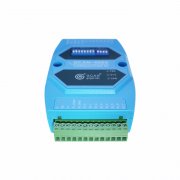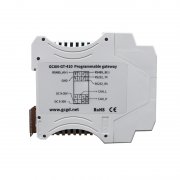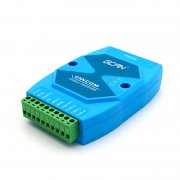Reasons for the appearance of the smart CAN interface card
For friends who are familiar with car control, the CAN bus can be said to be irresistible. It has fast data transmission speed, strong anti-interference ability, many connectable node devices, and long data transmission distance. The overall cost performance is quite high. It is for these reasons that the CAN bus has now become the most widely used automotive bus. However, the CAN bus has been around for decades now. In these decades, the field of automobile manufacturing has undergone tremendous changes. The most obvious example is that the bandwidth of the CAN bus is becoming insufficient. The theoretical maximum bandwidth of the CAN bus is 1000Kbps, which is generally not reached when it is actually used, but it is enough for people in the past. But now, there are more and more devices on the car that need to be connected to the Internet, and the limited bandwidth is dispersed into more parts. If it can still meet the actual needs, it will be a ghost. At the same time, the data bits of the CAN bus are only 8 bits, and they are still fixed. It seems that the center in the NBA will only grab the card and the point guard will only steal the assists. It can no longer meet the needs. What we need now is a center that can both grab a rebound and shoot a three-pointer, or a combo guard who can both score and assist. Therefore, the CAN FD bus is grandly launched.
The CAN FD bus is developed based on the CAN bus and can be regarded as a transition product between the CAN bus and the Flexray bus. Some friends may ask, why don't you directly use the Flexray bus instead of the CAN bus? Isn't it more in one step? The reason why there is CAN FD is a transitional product. One is because the technology of the Flexray bus is not yet very mature, and there are risks in various aspects when it is easily put on the market. Secondly, the Flexray bus knows from the name that it can't beat the CAN bus. If you want to replace it simply and rudely, the hardware and software have to be designed from scratch, and the time and cost cannot be tolerated. CAN FD is different. It is developed on the basis of CAN bus. The basic features are similar to CAN bus. Only the bandwidth has been greatly improved, from 1000Kbps to 5000Kbps. In addition, the most important point is that the data bits of the CAN FD bus have been increased from the eight bits of the CAN bus to 64 bits. The first eight bits are the same as the CAN bus. The latter dozens of bits are variable, and the flexibility is higher. Like a center who can shoot three points and can also assist, who can you develop without saying it? If at this stage we want to allow devices that originally only supported CAN bus communication to use CAN FD bus communication, only a smart can interface card is needed, such as the USBCAN II FD of Shenyang Guangcheng Technology.
The CAN FD bus is developed based on the CAN bus and can be regarded as a transition product between the CAN bus and the Flexray bus. Some friends may ask, why don't you directly use the Flexray bus instead of the CAN bus? Isn't it more in one step? The reason why there is CAN FD is a transitional product. One is because the technology of the Flexray bus is not yet very mature, and there are risks in various aspects when it is easily put on the market. Secondly, the Flexray bus knows from the name that it can't beat the CAN bus. If you want to replace it simply and rudely, the hardware and software have to be designed from scratch, and the time and cost cannot be tolerated. CAN FD is different. It is developed on the basis of CAN bus. The basic features are similar to CAN bus. Only the bandwidth has been greatly improved, from 1000Kbps to 5000Kbps. In addition, the most important point is that the data bits of the CAN FD bus have been increased from the eight bits of the CAN bus to 64 bits. The first eight bits are the same as the CAN bus. The latter dozens of bits are variable, and the flexibility is higher. Like a center who can shoot three points and can also assist, who can you develop without saying it? If at this stage we want to allow devices that originally only supported CAN bus communication to use CAN FD bus communication, only a smart can interface card is needed, such as the USBCAN II FD of Shenyang Guangcheng Technology.
Shenyang Guangcheng Technology USBCAN II FD smart can interface card is a high-performance bus communication interface card with integrated 2-way CANFD interface. This type of smart can interface card conforms to the USB2.0 bus high-speed specification, has two independent CAN/CAN FD channels, and the signals are isolated from each other. The PC can be quickly connected to the CAN (FD)-bus network through the USB interface to form the CAN (FD)-bus network field data processing and data acquisition CAN (FD) in the field bus laboratory, industrial control, intelligent community, automotive electronics network, etc. )-Bus network control node.
Shenyang Guangcheng Technology's USBCAN II FD smart can interface card is a powerful tool for CAN (FD)-bus product development and CAN (FD)-bus data analysis. At the same time, it has the characteristics of small size, plug and play, and is also a portable system user. Good choice. The USBCAN-II FD interface card comes with a USB interface and integrates a CAN interface electrical isolation protection module to prevent damage to the device due to instantaneous overcurrent/overvoltage and enhance the reliability of the system in harsh environments.






